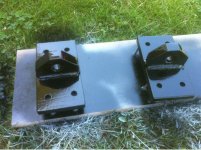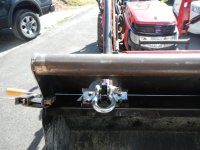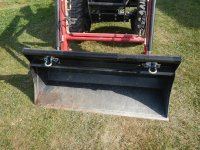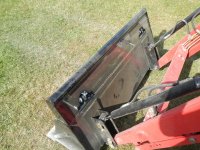I have reviewed all the other bucket mod threads I could find, and I've decided that I am going to put hooks and a 2" hitch receiver on my bucket. I'd like to get some input on the best way to install them on my specific bucket.
View attachment 291015
The bucket is made of ... well, my caliper says 5/16", but that seems like kind of an oddball size, so I suspect it's more like 1/8" with a 1/32" coat of paint.
View attachment 291016
Here's a top view of the bucket, so you can see what I'm working with. I understand from other threads that I'm going to have to reinforce the top of the bucket. Since the top is more or less parallel with the bottom, I'm thinking it's at a fine angle, and I believe I will just weld a piece of flat stock to the top of the bucket, with the hooks and receiver tube welded to it.
View attachment 291017
What thickness of stock is recommended? I'm thinking somewhere around 1/4" to 3/8"?
I know that I need not to have the hooks outside the lift arms, but I would like to have them farther out than that, and I would really like to have them in line with the lift arms if at all possible. What about doing the reinforcing sheet like this:
View attachment 291018
Or maybe even this:
View attachment 291020
That last one concerns me a little bit, because it will involve welding over the welds that hold the bucket to the bracket. I'm not sure I want to mess with that... I don't know if that's just trepidation, or if there is any real risk there.
For the reinforcing stock, is a complete weld along the entire length recommended, or would several inches of bead spaced out over the length of the reinforcing piece do?
The bucket is only 1/8" thick, and I'm confident that I can weld on material that thin without burning through. But I usually use 3/32" electrodes. Given what these welds are going to be asked to hold, I wonder if more than one 3/32" bead is called for, or whether I would be better off to step up to 1/8". I'd much rather run a single 1/8" bead in the joint than three 3/32" beads. There's just a lot more room to screw things up with the multiple passes. Also, I'm not sure how the variable thickness of the metals to be joined is going to affect things. In the past, when I have played with that, I have had a little trouble getting the heat to go where I want it to. The thinner piece gets hot faster than the thicker piece. Any advice would be appreciated.
I realize that some of these welding questions may start to put this project in the category of, "If you have to ask, you shouldn't be doing it," but given the expected loads that will be put on the welds, my gut is that this is within my capabilities. The welds are easy lap joints in the flat position. The loader has about a 1000 lb capacity, so that's the MOST that they will be asked to carry. Worst case scenario is that the whole thing breaks away and the trailer that I'm moving goes down a hill--but the trailer has, what, 200 lbs tongue weight empty? I think I'm capable of pulling this off, even at my level of experience, but if y'all disagree, I'll certainly take that into consideration.



